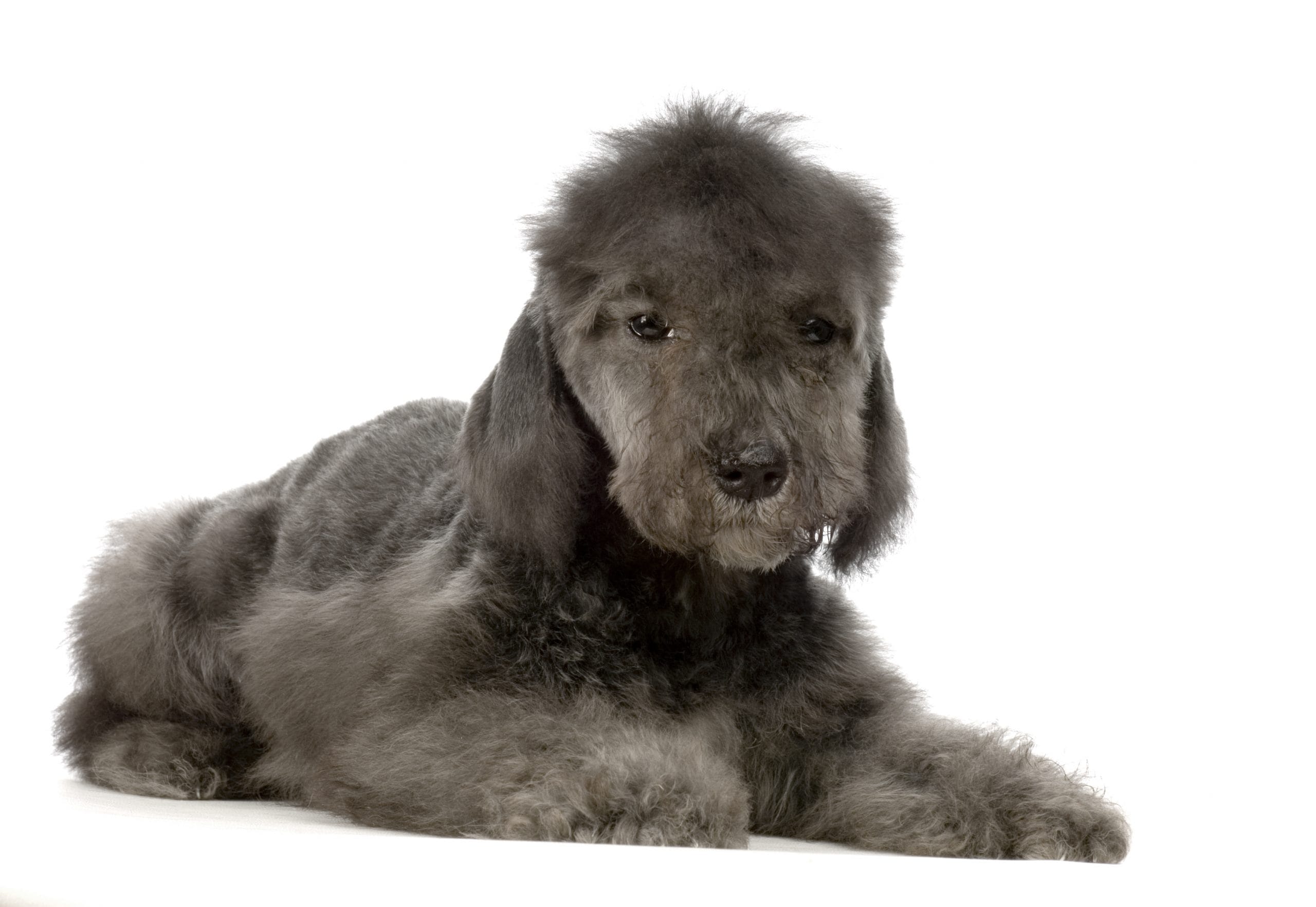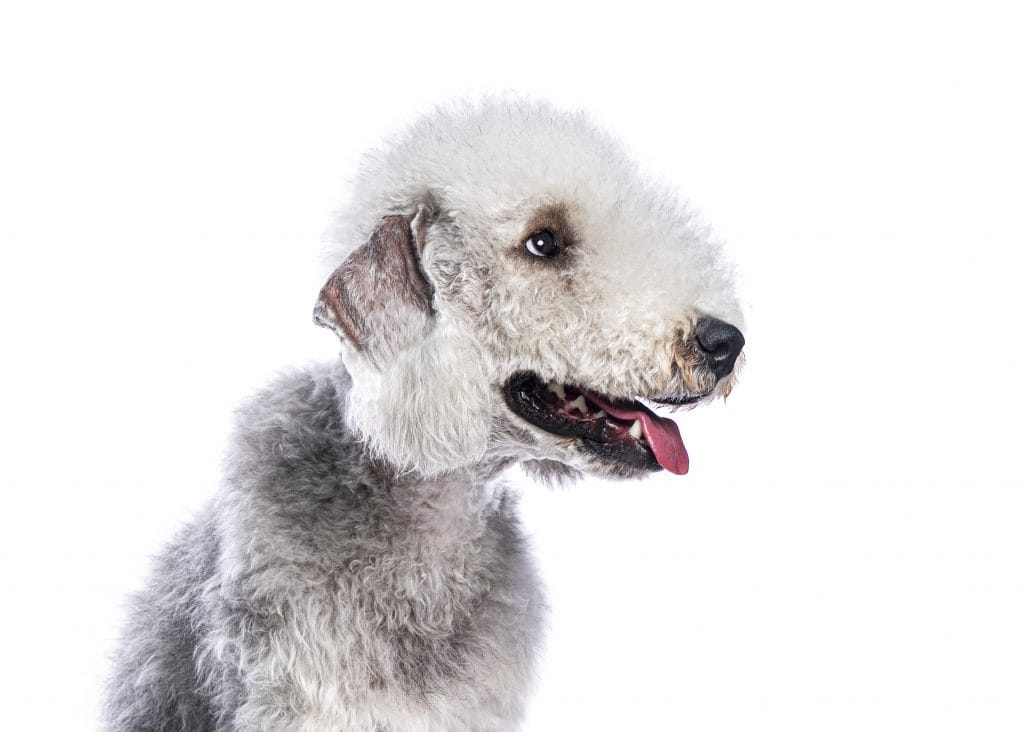
A non-shedding terrier with curls? Yes, there is! The Bedlington Terrier is a very unusual representative of its kind. While its appearance is reminiscent of a lamb, it is quite a real terrier in character. It is shrewd, independent, clever and extremely charming. Not to forget: the noticeable hunting instinct! If you know how to take the charming Brit, you have a loyal and active companion for sports and everyday life.
Lovable Englishman with extraordinary ancestors
The Bedlington Terrier is a dog breed that is unmistakable thanks to its striking appearance. Its genetic basis is a real supermix of numerous British dog breeds: From the Scottish Hunting Terrier to Greyhounds, Otterhound and English Terrier breeds, a wide range of different construction dogs and sight hunters have shaped this extraordinary dog breed. At the beginning of the 19th century, the breeding of the Bedlington Terrier began in the north of England, very close to the border with Scotland, with a robust, fast and eager dog that could reliably supply its owners with rabbits.
However, these original “Beddis” do not yet have much in common with today’s terriers in the sheep look. It was not until about 100 years ago that the development of today’s Bedlington began with an increased interest in breeding shows. Today’s typical breed characteristics such as the upwardly curved back or the ram’s nose as well as the poodle-like coat structure are modern breeding goals.

The character of the Bedlington Terrier
In its beginnings, the “Beddi” was a real all-rounder. Like most terrier breeds, it was one of its tasks to keep the home farm free of rats and chicken predators. It is therefore alert and ready at any time to respond to a movement stimulus. As an owner, you still have to deal with this hunting instinct today. As an independent hunter, this breed brings a high degree of courage, self-confidence and drive. Once “on the hunt”, the Bedlington is difficult to recall. Small animals in one’s own household can therefore be just as endangered as a free-roaming cat.
It is thanks to the sighthound ancestors that the long-legged terrier loves to run and jump. He is full of energy and joy of movement. With his humans, the Bedlington is honest, cooperative and lovable. It is not for nothing that he is considered the gentlest terrier and brings a good portion of “Will to Please” – the willingness to cooperate – into the dog-human relationship. He is intelligent and learns quickly, which makes training easy on the one hand, but also a challenge on the other. Because making nonsense on his own is just as welcome to the Beddi as serious work.
Education and Husbandry
The high-legged terriers are not only considered the gentlest terrier breed, but are also quite sensitive. When training, it is therefore all the more important to pay attention to a calm, consistent and at the same time fair approach. The Bedlington Terrier needs clear leadership, but at the same time attaches importance to always being treated with respect.
The charming bundle of energy prefers to be with him all the time. Nevertheless, the Bedlingtons learn well to stay alone for hours. The cheerful terrier also likes to sleep through this time on the couch or in the basket at home. The prerequisite for this, however, is regular and breed-appropriate workload.
The robust four-legged friends have a great need to run and exercise. Long walks and dog sports such as agility or lunging benefit this need. When fully grown, the handy terriers are wonderful companions for jogging, cycling or even horseback riding. To make this possible, however, work must be done early on to control the hunting instinct. Tasks that include hunting a visible “prey” are particularly popular. Some dog racetracks offer courses or training sessions for non-greyhounds – your Bedlington Terrier might like that!
Properly educating Bedlington Terriers from the beginning
From the first day in the new home, the focus is on suitability for everyday use. Basic commands such as “sit” and “down” are usually learned quickly by the Bedlington. However, impulse control and frustration tolerance are more important. Both are crucial for a relaxed life with a hunting terrier at your side.
A simple game that trains these important qualities in the first few weeks at home is the treat game: Sit down with your puppy and place a treat on your leg. If the puppy pounces on it, cover the treat with his hand – and wait. If he can’t reach it, he will eventually sit down and think. Raise his hand and allow him to eat it now. Soon your puppy will sit down right when the game begins. Now place the treat in different places and practice active release. This trains his patience, self-control and dealing with not being allowed to have something. It is the basis for controlling the hunting instinct.
Just as important as these exercises is socialization. Due to their sensitivity, Bedlingtons tend to become excessively anxious or even fear-aggressive if they are not sufficiently socialized. Thanks to their fundamentally open-minded attitude towards all dogs and people, this is not a problem with the lovable “Beddi”. Take advantage of the offers of dog schools and puppy playgroups. But also an afternoon in the park, where you sit comfortably on a blanket and watch people and dogs with your puppy, is tremendously instructive for the dog dwarf.
Caring for the Bedlington Terrier
The structure of the Bedlington Terrier’s coat is reminiscent of a poodle – or even a lamb. It is soft, curly and does not shed. Since it knots easily, regular brushing is important. If you keep your hair short with a shear, you will reduce the effort to a minimum.
In addition, it is best to check your eyes, ears, teeth and claws daily. Most Beddis are very communicative dogs that point out injuries and illnesses to their humans.
Special features and health
The robust dog breed has hardly any typical hereditary diseases. Only copper toxicosis has occurred more often in the past, which is why serious breeding pays close attention to it today. It is therefore advisable to buy a puppy from a registered, tested breeder. Since the Bedlington Terrier is recognized by the VDH – the Association for the German Canine Society – it is easy to find affiliated breeders.
When it comes to feeding and care, the “Beddis” are considered uncomplicated. With an active life, plenty of exercise and adapted feeding, Bedlington Terriers can live up to 15 years or even older.
ProfileBedlington Terrier
| Race: | Bedlington Terrier |
| Origin: | Great Britain |
| Classification: | Terrier, Section 1 High-legged Terriers |
| Size: | by 41 centimeters, females slightly smaller than males |
| Weight: | 8 to 10 kilograms |
| Physique: | Slim, sporty and flexible, with an upwardly arched back and bridge of the nose |
| Eyes: | dark, calm eyes |
| Ears: | medium-sized ears hanging close to the head |
| Coat and color: | light, soft, strongly curly top coat with a flax-like structure |
| Particularities: | only terrier that does not shed at all |
| Character | friendly, intelligent, cuddly, alert and happy to hunt |
| Bless you: | few typical hereditary diseases are known, the rare copper toxicosis is excluded in the breeding program |
Other terrier breeds you might also like:
- Airedale Terrier: As the “King of the Terriers”, the conspicuously black and brown Airedale occupies a special position among its close relatives: On the one hand, it has the typical toughness and independence of the terriers, but on the other hand, it has a high willingness to cooperate and unlimited loyalty.
- Australian Terrier: Small, robust and brave – if you want a handy companion that is very enthusiastic about every fun and loves its people more than anything, the Australian Terrier is the right choice! The clever dwarfs have everything you could wish for in a family and companion dog
- Border Terrier: The Border Terrier is one of the most popular family dogs in its homeland – in the far south of Scotland. The clever and handy little terrier has a great character and little shedding fur.
- German Hunting Terrier: The German Hunting Terrier is one of the toughest, most straightforward and most hunting dog breeds in this country. Its courage and doggedness at work make it an outstanding hunting dog. For the owner, its determination and independence can become a challenge.
- Irish Soft Coated Wheaten Terrier: As an all-rounder, the Irish Soft Coated Wheaten Terrier has been useful on Irish farms for centuries. Herding dog, guard and hunter in one, loyal and affectionate at the same time – the wheat-blonde, robust dog offers many advantages.
- Kerry Blue Terrier: Games, fun and hunting instinct – the Kerry Blue Terrier is a charming, but also serious companion with the typical terrier toughness. His lively nature, his intelligence and the will to work make the bearded Irishman an attentive four-legged friend, but he gets bored quickly.
- Irish Terrier: The Irish Terrier is one of the largest and quietest terrier breeds. Their long-legged, elegant physique is just as appealing as their friendly, child-loving character. With good socialization and consistent training, this dog breed is the right choice for active owners.

Leave A Comment